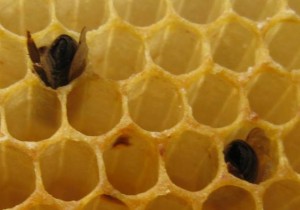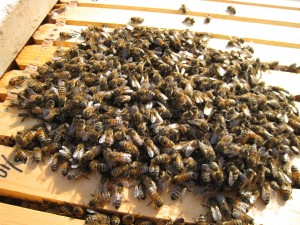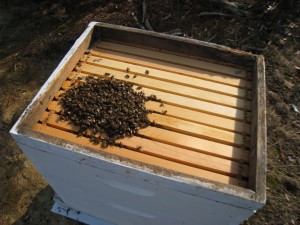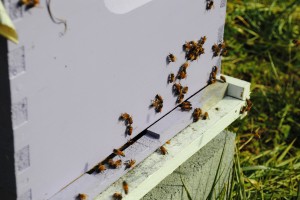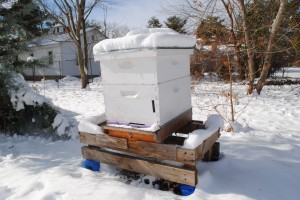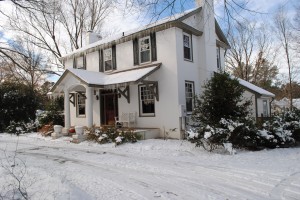We have had a good stretch of fairly cold weather over the last couple of weeks in central Virginia. Here to the east of Richmond, it’s been dipping into the 20’s nearly every night. Although this used to be normal a few decades back, I do not recall a stretch of cold like this in December in the recent past.
So, how does this effect the bees? The key for the bees is really the daytime temperature. If it rises above 40 during the day, my bees move around a bit (within the hive) and get their nourishment. We did have several days, back-to-back, that did not breach 38, but it was not long enough of a stretch to cause the bees problems, in my opinion.
The key to remember is that bees rarely die from cold. They die from starvation. I read a study last year where a scientist put a few hives in a deep freezer where the temperatures were kept below -20 degrees! He made sure the bees had plenty of stores and monitored them. They did just fine.
How do bees starve? They can either run out of food or the weather stays very cold (daytime temperatures do not rise above 30 degrees) for a long time. I do not know for sure what ‘a long time’ is, but it is probably several weeks. Bees do not move much when it is really cold. So, they eat the honey around them to keep warm but it remains too cold to move over to another batch of honey (or to retrieve honey from another area and bring it back to the cluster.) In either case, no hive should be starving at this point. But, it’s good to keep in mind come Janurary-February. You can move frames of honey to the cluster (either from the same hive or even from another hive.)
At any rate, the main reason I decided to post boils down to a little situation that occurred yesterday. Basically, the temp’s jumped up into the mid-40’s. At around 40, my bees come outside to use the restroom and stretch their legs. In the mid-40’s, I do not have a problem cracking the cover to look in, as long as it is not too windy. By ‘look’, I actually mean just that: look. I am definitely not breaking the hive apart in any way. But, it’s only December and I know that none of my hives are in any trouble now (well, I do not KNOW this, but I do know that any hive having a problem now is beyond my control – plus, I really don’t want that gene pool anyway.) But, I do have a few Nuc’s that I am overwintering. These guys do not have the stores that my regular hives do and this is my first year overwintering them. So, I needed to have a look. I decided to keep this to one double-Nuc (a deep that has been split in half to hold two 4 frame Nuc’s.)
Well, I can tell you that they still have the energy to attack. I guess I was lazy, as I did not suit up. This basically meant that my neighbors got to watch me sprint away from my hive the moment that I opened her up. They came out, armed for bear. In the end, I got a look at both clusters and could still see a good amount of capped honey on the frames. I was actually sort of surprised, for some reason. I guess I have not really bought into this ‘overwinter a few pounds of bees on 4 frames’ idea. Despite my subconscious misgivings, these bees were doing great. Today, when it breached 40 again, I put two cups of sugar on both hives (1 layer newspaper on top of the frames, two cups sugar and then used a cone to direct a few spritz of water onto the sugar to dampen it a bit.) This is called insurance. I currently do not subscribe to doing this with a seasoned hive, but I am not that confident in these Nuc’s, so they are going to get the full guns this year. In future years, once I have more experience with this, I may change my protocol.
At any rate, the amusing story took place with moving this double nuc. As mentioned above, it got cold quicker then I thought it would. So, I ended up with 1 double Nuc down at the Goose Pond Apiary. I like to have my Nuc’s close. Plus, this Nuc didn’t receive the sheltered Southern sun that I give my home Nuc’s behind my huge patch of Burford Hollies. This area was the first to have complete snow melt after all of the snows last year. It really is the best wintering location that I have and I wanted these Nuc’s in it. The other problem was that I never took the mason jars of sugar water off of them (another issue with having a distant Nuc yard.) So, I had to move them and I didn’t want to break the cover and let any bees out before I transported them. I hoped that the jars were empty.
This was a learning experience (never ‘hope’ for empty mason jars), as neither jar was empty. Once I got the double nuc into the back of my Trailblazer, I immediately noticed sugar syrup seeping out of two corners of the hive. This was a potential disaster. I was not sure if any of the bees were even alive. But, if they were, I just introduced a major threat to them. Bees cannot get wet in the Winter as they simply cannot generate the internal body heat to deal with it. They die. In my mind’s eye, I could see both of my clusters covered in syrup at that exact point (although I did occasionally waffle to the notion that all of the bees were probably already dead anyway:).
I am not sure if this made any difference, but I simply jacked the temp in my trailblazer up on the way back to Richmond. Once I got there, I parked in the field beside my house and listened to the hive. I could definitely here the bees buzzing! They were alive! So, I let them sit in the sun, remaining plugged up in my car (the inside of my black Trailblazer always stays comfy in the sun). I took my Greenhouse temp monitor and placed it in the car, monitoring it throughout the day. It did get into the lower 70’s, but no higher. My goal was simple: If some bees did get doused, I wanted them to be at a temperature that they would ‘lick’ it off of one another. By around 2 pm, the weather was still in the lower 40’s and I could see bees at my other Nuc’s making cleansing runs. So, I put them out in the field, popped the cover quickly to get the mason jars, and opened the entrances. Who knows if this helped or hurt, but I am recording it here as another one of my adventures. The bees looked great today, so I do not think it hurt much – it may have helped a ton. I am good with it, either way.
I guess the next hive update will be in January, under the assumption that we have some days that climb into the 40’s and are not too windy (ideally, the sun will be out, but I do not make that a rule for Winter checks, just a nice-to-have.)
